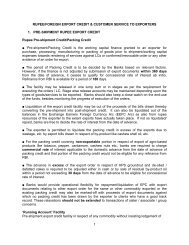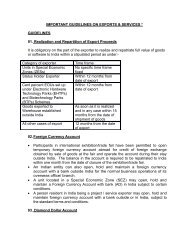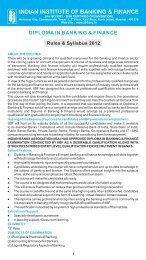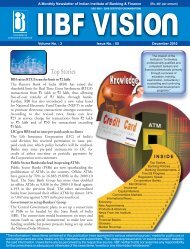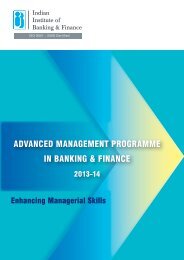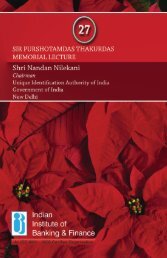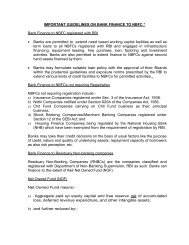Create successful ePaper yourself
Turn your PDF publications into a flip-book with our unique Google optimized e-Paper software.
special featurecharged on advances. This may be due to strongercommitment of PSBs to low-yielding priority advances.We observe no significant difference in the ratio PATto average assets. This ratio indicates the incomegenerating capacity of the assets and here it appears thatboth PSBs and PVTBs have similar income generationpotential.We find that the PSBs significantly outperform thePVTBs on the ratio of interest income to total income.This finding is corroborated in the complementaryratio of Non-interest income to total income. The findingpoints to the product innovation strongly pursued bythe PVTBs. PSBs have traditionally been lendersand they have lagged behind the private sector banksin creating non-fund based income opportunities forthemselves.Liquidity :LATA LATDPSB PVTB PSB PVTBMean 8.71 10.64 10.16 13.37t Stat -1.45 -1.91Significance ** **** Significant at 5%The PSBs have underperformed PVTBs in liquiditymeasures as well. This finding is in line with the highercapital adequacy observed earlier in case of PVTBs. ThePSBs have underperformed PVTBs significantly on boththe liquidity measures, namely Liquid Assets to totalassets as well as liquid assets to total deposits.SUMMARY OF FINDINGS AND CONCLUSION1. PSBs have lower capital adequacy than PVTBs. Thereason appears to be the higher equity base of PVTBsand low debt. The PSBs are more aggressive inlending. However, the PSBs appear to have parkedmore funds in Government securities than the PVTBs.2. The asset quality of PSBs is superior to PVTBsreflected in their gross NPAs. However, PVTBs havetaken prudential and mitigating measures and there isno significant difference in the net NPA performance ofthese banks. However, PSBs have parked fewerfunds in investments than the PVTBs.3. The management efficiency of PSBs is similar to thatof PVTBs in that there is no significant difference intheir ability to convert deposits into loans and profit peremployee. However, business per employee in caseof public sector banks is far superior to the privatesector banks.4. The earnings performance of PSBs is also notvery different from the PVTBs. However, PSBs areoperating on a thinner spread owing to low yieldingloans despite their having better access to low costdeposits than PVTBs. However, the income of publicsector banks is mainly interest income. The non-fundbased income (or fee income) of PSBs is significantlylower in comparison to the PVTBs.5. On liquidity yardstick, the PVTBs have outperformedthe PSBs. They have more investment in liquidassets in proportion to both their total assets andtotal deposits respectively.Although the findings of this research may not bein line with the popular perception that PSBs havebetter capital adequacy and liquidity than the privatesector banks, it cannot be gainsaid that PSBs doneed marked improvement in the capital adequacy,operational efficiency and liquidity. It will be in the longterm interests of the banks as well as economy.References- Barr; R. S., Seiford; L. M. and Siems ; T. F. (1993)“An Envelopment - Analysis Approach To Measuring TheManagerial Efficiency Of Banks” Annals Of OperationsResearch 45 (1993) 1-19.- Bodla, B. S. and Verma R. (2006), ‘Evaluating Performanceof Banks through CAMEL model : A case study of SBI andICICI’ ICFAI Journal of Bank Management, Vol - V, No.3,pp 49-63.- Chakraborty K. C. ( 2005), “ Management of NPAs: Trends andChallenges”, Chartered Financial Analyst, Vol 10, p 30.- Chakraborty R. and Chawla G. (2005), Bank Efficiency InIndia Since Reforms : An Assessment”, Money and Finance,Vol - 2, p 31.- Chartered Financial Analyst magazine, various issues- CMIE - Prowess database .- Godse V. T. (1996), “CAMEL for Evaluating the performanceof Banks”, IBA Bulletin, Vol - 18, No. 8, p 8.- Government of India (1998), “ Report of the committee onBanking Sector Reforms” (Narsimham Committee Report-2),New Delhi.50October - December 2011The Journal of Indian Institute of Banking & Finance



